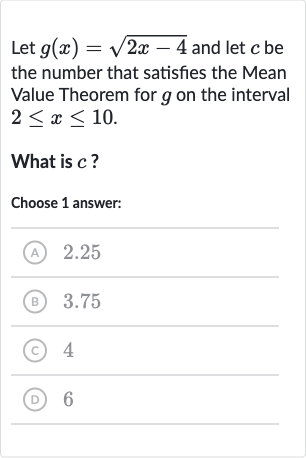AI tutor
Welcome to Bytelearn!
Let’s check out your problem:

Let and let be the number that satisfies the Mean Value Theorem for on the interval .What is ?Choose answer:(A) .(B) .(C) (D)
Full solution
Q. Let and let be the number that satisfies the Mean Value Theorem for on the interval .What is ?Choose answer:(A) .(B) .(C) (D)
- Understand the MVT: Understand the Mean Value Theorem (MVT). The MVT states that if a function is continuous on the closed interval and differentiable on the open interval , then there exists at least one number in such that .
- Verify Conditions for MVT: Verify that satisfies the conditions of the MVT on . is continuous and differentiable on because the square root function is continuous and differentiable wherever its argument is positive, and is positive for all in .
- Calculate and : Calculate and .
- Calculate Average Rate of Change: Calculate the average rate of change of on . The average rate of change is .
- Find : Find , the derivative of .
To differentiate , we use the chain rule. - Set equal to Average Rate: Set equal to the average rate of change and solve for .To solve for , we square both sides of the equation to get rid of the square root.Now, cross-multiply to solve for .
More problems from Solve quadratic inequalities
QuestionGet tutor help
QuestionGet tutor help
QuestionGet tutor help
QuestionGet tutor help
QuestionGet tutor help
QuestionGet tutor help
QuestionGet tutor help
QuestionGet tutor help
